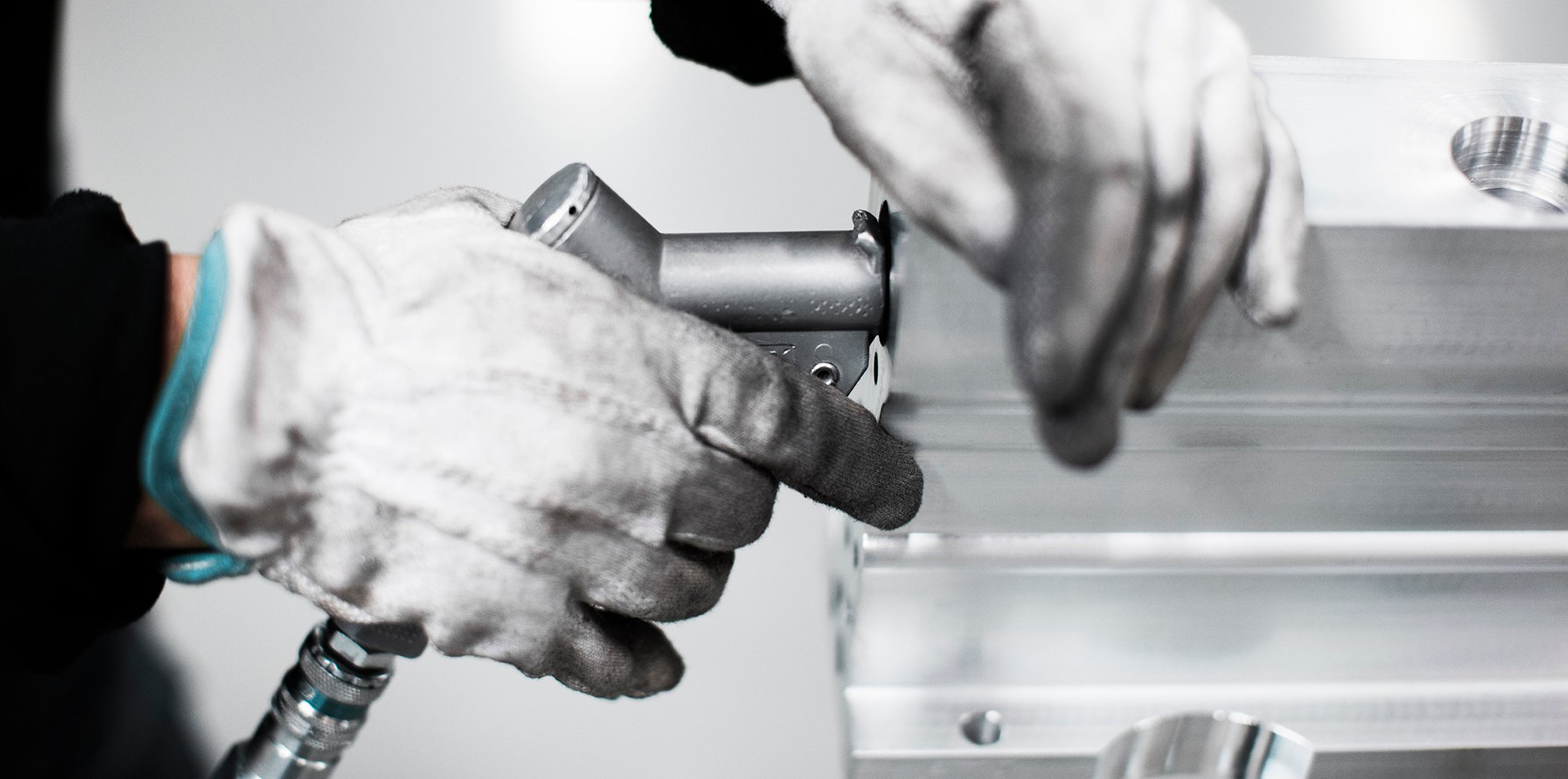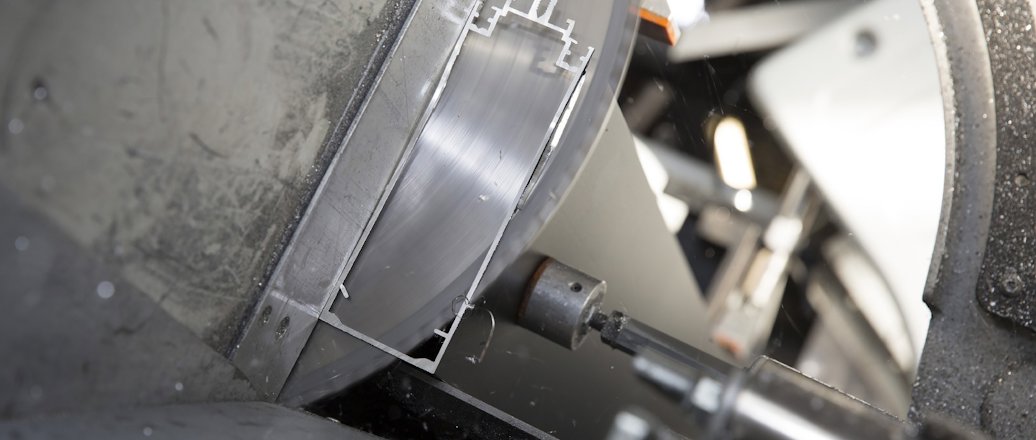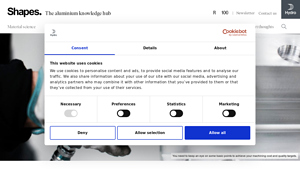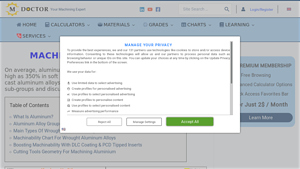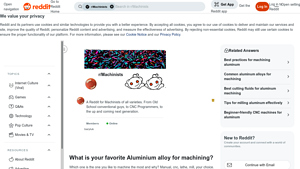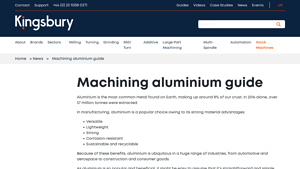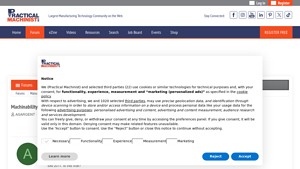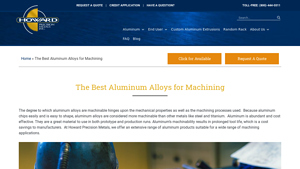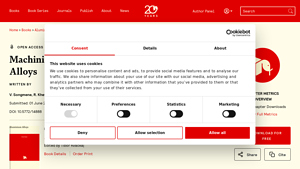Aluminium Machinability Guide: Type, Cost, Top List…
Introduction: Navigating the Global Market for aluminium machinability
Navigating the complexities of aluminium machinability can present significant challenges for international B2B buyers, especially when it comes to sourcing the right materials for their manufacturing processes. Understanding the varying machinability of different aluminium alloys is crucial; it can directly influence production efficiency and product quality. This guide aims to demystify the intricacies of aluminium machinability by covering essential topics, including the distinct types of aluminium alloys, their applications across industries, effective supplier vetting strategies, and cost considerations.
As aluminium continues to gain traction in global markets, particularly in regions such as Africa, South America, the Middle East, and Europe, informed purchasing decisions become paramount. This guide equips B2B buyers with actionable insights to navigate the aluminium supply chain confidently. By highlighting key variables that affect machinability—such as alloy composition, machining techniques, and potential tooling solutions—this resource empowers businesses to optimize their production processes and reduce costs. Whether you are in aerospace, automotive, or construction, understanding these factors will enhance your ability to make strategic sourcing decisions and ensure the successful implementation of aluminium in your projects.
Understanding aluminium machinability Types and Variations
| Type Name | Key Distinguishing Features | Primary B2B Applications | Brief Pros & Cons for Buyers |
|---|---|---|---|
| Wrought Aluminium Alloys | High machinability, versatile, and good mechanical properties | Aerospace, automotive, construction | Pros: Cost-effective, excellent surface finish. Cons: Lower strength compared to some cast alloys. |
| Cast Aluminium Alloys | High silicon content, lower machinability, and rapid tool wear | Automotive parts, consumer goods | Pros: Excellent chip breakage, good for complex shapes. Cons: Higher tool wear, less economical for extensive machining. |
| Aluminium Lithium Alloys | Lightweight with high strength-to-weight ratio | Aerospace, defense, high-performance applications | Pros: Superior strength, reduced weight. Cons: Higher cost, lower machinability. |
| 2xxx Series Aluminium Alloys | Copper as the primary alloying element, good strength | Aerospace, military applications | Pros: High strength, suitable for heat treatment. Cons: Prone to corrosion, lower machinability. |
| 6xxx Series Aluminium Alloys | Silicon and magnesium content, excellent machinability | Structural applications, general engineering | Pros: Good corrosion resistance, versatile. Cons: Moderate strength compared to 2xxx and 7xxx series. |
What Are the Characteristics of Wrought Aluminium Alloys?
Wrought aluminium alloys are favored for their superior machinability and mechanical properties, making them suitable for a wide range of applications, including aerospace and automotive industries. These alloys are typically rolled or extruded, allowing for precise shapes and sizes. When purchasing wrought aluminium, buyers should consider the specific alloy composition and temper, as these factors significantly influence performance and cost-effectiveness.
How Do Cast Aluminium Alloys Differ in Machinability?
Cast aluminium alloys contain higher silicon content, resulting in lower machinability compared to wrought alloys. They are ideal for applications requiring complex geometries, such as automotive parts and consumer goods. While they provide excellent chip breakage during machining, the increased wear on cutting tools can lead to higher operational costs. B2B buyers should evaluate the trade-off between machining efficiency and tool longevity when selecting cast alloys.
What Are the Advantages of Aluminium Lithium Alloys?
Aluminium lithium alloys are recognized for their lightweight and high strength-to-weight ratio, making them particularly valuable in aerospace and defense applications. However, their machinability is lower compared to traditional aluminium alloys, and they come at a premium price. B2B buyers should weigh the benefits of reduced weight and enhanced performance against the higher costs and potential machining challenges.
Why Choose 2xxx Series Aluminium Alloys?
The 2xxx series aluminium alloys, primarily alloyed with copper, offer high strength and are commonly used in aerospace and military applications. Their heat-treatable nature enhances their mechanical properties, but they are less resistant to corrosion compared to other series. Buyers should consider the specific application requirements, as well as the need for protective coatings or treatments to mitigate corrosion.
What Makes 6xxx Series Aluminium Alloys Versatile?
6xxx series aluminium alloys are known for their excellent machinability, good corrosion resistance, and versatility in structural applications. These alloys, which include silicon and magnesium, are widely used in general engineering and construction. When purchasing, buyers should assess the alloy’s strength and formability to ensure it meets the demands of their specific applications.
Key Industrial Applications of aluminium machinability
| Industry/Sector | Specific Application of aluminium machinability | Value/Benefit for the Business | Key Sourcing Considerations for this Application |
|---|---|---|---|
| Aerospace | Precision components for aircraft structures | Lightweight materials improve fuel efficiency and performance | Compliance with aerospace standards and certifications |
| Automotive | Engine components and body panels | Enhanced performance and reduced weight for better fuel economy | Supplier reliability and ability to meet tight tolerances |
| Construction | Structural frameworks and facades | Cost-effective fabrication and improved durability | Material availability and local sourcing options |
| Electronics | Heat sinks and housings for electronic devices | Efficient thermal management and lightweight designs | Compatibility with various machining processes |
| Marine | Boat hulls and components | Corrosion resistance and lightweight properties for better performance | Specific alloy selection to meet marine standards |
How Is Aluminium Machinability Applied in the Aerospace Industry?
In the aerospace sector, aluminium machinability is critical for producing precision components used in aircraft structures, such as frames and wings. The lightweight nature of aluminium alloys contributes to improved fuel efficiency and performance. Buyers in this industry must ensure that their suppliers adhere to stringent aerospace standards and certifications to guarantee the reliability and safety of components.
What Are the Applications of Aluminium Machinability in the Automotive Sector?
Aluminium machinability plays a vital role in manufacturing engine components and body panels in the automotive industry. The ability to machine aluminium efficiently allows for the production of lightweight parts, leading to enhanced performance and reduced fuel consumption. Buyers should prioritize suppliers that demonstrate reliability and can meet the tight tolerances required for high-performance automotive applications.
How Is Aluminium Machinability Utilized in the Construction Industry?
In construction, aluminium machinability is leveraged for creating structural frameworks and facades. The ability to easily machine aluminium profiles translates into cost-effective fabrication processes while maintaining high durability. International buyers should consider the availability of materials and local sourcing options to minimize lead times and transportation costs.
What Role Does Aluminium Machinability Play in Electronics Manufacturing?
Aluminium machinability is essential for producing heat sinks and housings for electronic devices. The efficient thermal management properties of machined aluminium help in maintaining optimal operating temperatures, while its lightweight design is crucial for portable electronics. Buyers must ensure compatibility with various machining processes to achieve the desired specifications and performance.
How Does Aluminium Machinability Benefit the Marine Industry?
In the marine sector, aluminium machinability is utilized for fabricating boat hulls and components. The corrosion resistance of aluminium, combined with its lightweight nature, enhances the overall performance of marine vessels. Buyers should focus on specific alloy selections that meet marine standards to ensure longevity and reliability in harsh marine environments.
3 Common User Pain Points for ‘aluminium machinability’ & Their Solutions
Scenario 1: Navigating Chip Breakage Challenges in Aluminium Machining
The Problem: B2B buyers often encounter significant issues with chip breakage when machining aluminium. Chip entanglement can lead to unexpected machine downtimes, increased tool wear, and inferior surface finishes. This problem is particularly pronounced in wrought aluminium alloys, where the size and shape of chips vary greatly. Buyers may find that high-strength alloys, such as those from the 7xxx series, exacerbate these issues, leading to frustration and increased production costs.
The Solution: To effectively manage chip breakage, it is critical to select the right aluminium alloy based on the intended machining process. Utilizing chip maps and conducting chip counting can help assess chip breakage under various cutting parameters. B2B buyers should consider sourcing alloys specifically designed for machinability, such as the 6061M and 6082M alloys, which offer improved chip behavior without the inclusion of restricted alloying elements like lead. Additionally, adjusting cutting speeds and feeds based on the specific alloy being machined can optimize chip formation and minimize breakage. Training machine operators to recognize the signs of chip entanglement and to adjust parameters proactively can further reduce downtime and enhance overall machining efficiency.
Scenario 2: Selecting the Right Aluminium Alloy for Specific Applications
The Problem: B2B buyers frequently struggle with choosing the appropriate aluminium alloy for their machining needs, particularly when they require specific mechanical properties alongside machinability. Missteps in alloy selection can result in subpar product performance, increased production costs, and wasted materials. For instance, selecting a high-silicon cast aluminium alloy may lead to rapid tool wear, while a wrought alloy may not deliver the necessary strength.
The Solution: To overcome this challenge, buyers should prioritize a thorough understanding of the distinct properties of different aluminium alloys. Engaging with suppliers who can provide detailed technical data and performance specifications is crucial. Buyers should consider the intended application of the finished product—whether it demands high strength, corrosion resistance, or lightweight characteristics—and choose an alloy that best meets those needs. Implementing a standardized evaluation process for alloy selection, which includes assessing machinability rates and testing with small-scale production runs, can lead to more informed decisions. Collaboration with metallurgical experts or leveraging advanced software tools for alloy simulation can also facilitate better choices and enhance product outcomes.
Scenario 3: Addressing Tool Wear and Maintenance in Aluminium Machining
The Problem: Tool wear is a common pain point in aluminium machining, often leading to increased operational costs and compromised product quality. B2B buyers may find that standard cutting tools wear out more quickly when machining certain aluminium alloys, particularly those with higher strength or those that are abrasive. This not only raises the costs of replacement tools but also leads to disruptions in production schedules.
The Solution: To mitigate tool wear, buyers should invest in advanced cutting tools that are specifically designed for aluminium machining, such as those with Diamond-Like Carbon (DLC) coatings or Polycrystalline Diamond (PCD) tips. These tools can significantly enhance wear resistance and allow for higher cutting speeds, ultimately reducing the frequency of tool changes. Additionally, implementing a proactive maintenance schedule that includes regular inspection and cleaning of tools can extend their lifespan. Buyers should also consider training their teams on optimal cutting techniques and parameters to minimize wear while maximizing efficiency. Finally, establishing a feedback loop with tool suppliers can provide insights into the latest advancements and help in selecting the best tools for specific machining tasks.
Strategic Material Selection Guide for aluminium machinability
What Are the Key Properties of Common Aluminium Alloys for Machinability?
When selecting aluminium alloys for machining, understanding their key properties is essential. Here, we analyze four common materials used in the industry: 6061, 7075, 2024, and 5083. Each alloy has unique characteristics that influence machinability, performance, and suitability for various applications.
How Does Aluminium Alloy 6061 Perform in Machining Applications?
6061 is one of the most versatile and widely used aluminium alloys, primarily due to its excellent machinability and mechanical properties. It features a balanced composition of magnesium and silicon, providing good corrosion resistance and weldability. The alloy is suitable for applications that require moderate strength and good surface finish.
Pros: 6061 offers a good balance of strength, corrosion resistance, and machinability, making it ideal for a variety of applications, including automotive and aerospace components. Its relatively low cost compared to other high-strength alloys is another advantage.
Cons: While 6061 is versatile, it may not perform as well under high-stress conditions compared to stronger alloys like 7075. Additionally, its machinability can be affected by the specific temper used.
Impact on Application: This alloy is particularly effective in environments where moderate strength and corrosion resistance are required, such as in marine applications.
Considerations for International Buyers: Buyers should ensure compliance with local standards, such as ASTM or DIN, and be aware of regional preferences for specific tempers.
What Makes Aluminium Alloy 7075 a Popular Choice Despite Its Limitations?
7075 aluminium alloy is known for its exceptional strength, making it a popular choice in industries like aerospace and defense. It contains zinc as its primary alloying element, which significantly enhances its mechanical properties.
Pros: The high strength-to-weight ratio of 7075 makes it suitable for applications where performance is critical. It also has good fatigue resistance, making it ideal for high-stress components.
Cons: The alloy is more expensive than 6061 and can be more challenging to machine due to its hardness, leading to increased tool wear. This can result in higher manufacturing costs.
Impact on Application: 7075 is often used in applications that require high strength and durability, such as aircraft structures and military vehicles.
Considerations for International Buyers: Buyers should verify compliance with aerospace standards and consider the availability of specific tempers in their region.
Why Is Aluminium Alloy 2024 Considered a High-Performance Option?
2024 aluminium alloy is another high-strength option, primarily alloyed with copper. It is often used in aerospace applications due to its excellent fatigue resistance and machinability.
Pros: 2024 offers high strength and good machinability, making it suitable for complex shapes and components. Its fatigue resistance is particularly beneficial in applications subjected to cyclic loading.
Cons: The alloy has lower corrosion resistance compared to other aluminium alloys, which may necessitate protective coatings in certain environments. It is also more expensive than 6061.
Impact on Application: This alloy is ideal for aerospace components, where weight and strength are critical, but it may require additional surface treatments to enhance corrosion resistance.
Considerations for International Buyers: Buyers should be aware of the specific standards applicable to aerospace materials and ensure proper documentation for compliance.
What Are the Advantages of Using Aluminium Alloy 5083?
5083 aluminium alloy is known for its exceptional performance in extreme environments, particularly in marine applications. It is primarily alloyed with magnesium and has excellent corrosion resistance.
Pros: The alloy’s high resistance to seawater makes it ideal for shipbuilding and marine structures. It also offers good weldability and formability.
Cons: While 5083 has good machinability, it is not as easy to machine as 6061 or 7075, which may lead to increased manufacturing costs. It is also more expensive than some other options.
Impact on Application: 5083 is particularly suited for marine applications, where corrosion resistance is paramount, and strength is also required.
Considerations for International Buyers: Buyers in marine industries should ensure that the alloy meets local maritime standards and regulations.
Summary Table of Aluminium Alloys for Machinability
| Material | Typical Use Case for aluminium machinability | Key Advantage | Key Disadvantage/Limitation | Relative Cost (Low/Med/High) |
|---|---|---|---|---|
| 6061 | Automotive and aerospace components | Good corrosion resistance and machinability | Lower strength compared to 7075 | Medium |
| 7075 | Aerospace and defense applications | High strength-to-weight ratio | More expensive and harder to machine | High |
| 2024 | Aerospace components | Excellent fatigue resistance | Lower corrosion resistance | High |
| 5083 | Marine applications | Exceptional corrosion resistance | Not as easy to machine | Medium |
This strategic material selection guide provides B2B buyers with essential insights into the machinability of common aluminium alloys, enabling informed decisions that align with their specific application requirements and regional standards.
In-depth Look: Manufacturing Processes and Quality Assurance for aluminium machinability
What Are the Key Manufacturing Processes for Aluminium Machinability?
The manufacturing processes for aluminium machinability involve several critical stages that ensure the material’s properties are optimized for machining. These stages include material preparation, forming, assembly, and finishing, each employing specific techniques tailored to enhance machinability and quality.
How Is Material Prepared for Machining Aluminium?
Material preparation is the first step in the manufacturing process. It involves selecting the right aluminium alloy based on its properties, such as tensile strength, elongation, and machinability rating. Common alloys used include 6061 and 7075, with the former being favored for its excellent machinability and the latter known for its high strength.
Once the alloy is selected, it undergoes processes like extrusion or casting to create the desired shapes. This stage may also involve heat treatment to enhance mechanical properties, particularly for wrought alloys. For instance, heat-treated 6061 alloys can achieve significant strength improvements, making them ideal for demanding applications.
What Forming Techniques Are Employed in Aluminium Machining?
Forming techniques vary depending on the intended application of the aluminium component. Common methods include:
-
CNC Machining: This computer-controlled process allows for high precision and repeatability. CNC machining is particularly effective for intricate designs and tight tolerances, making it a popular choice for aerospace and automotive components.
-
Milling and Turning: These subtractive manufacturing processes are widely used in machining aluminium. The low cutting force required for aluminium allows for higher cutting speeds, reducing machining time and costs.
-
Drilling and Punching: These methods are employed for creating holes and shapes in aluminium components. The ability to achieve high-speed drilling is beneficial for production efficiency.
-
Welding and Joining: Techniques such as MIG and TIG welding are utilized when assembly is required. Proper selection of filler materials and parameters is crucial to maintain the integrity of the aluminium.
How Is Finishing Done to Ensure Quality in Aluminium Machining?
Finishing processes are essential for enhancing the surface quality and functionality of aluminium parts. Techniques include:
-
Anodizing: This electrochemical process increases corrosion resistance and surface hardness, making it ideal for components exposed to harsh environments.
-
Coating: Applying protective coatings can improve durability and aesthetic appeal. Options include powder coating and wet painting, depending on the required finish.
-
Deburring and Polishing: Removing sharp edges and improving surface finish can enhance the overall quality and performance of machined parts, reducing the risk of failure in applications.
What Quality Assurance Measures Are Standard for Aluminium Machinability?
Quality assurance (QA) is a critical aspect of the manufacturing process for aluminium components, ensuring that products meet international standards and customer specifications.
Which International Standards Should B2B Buyers Be Aware Of?
The most recognized international standard for quality management is ISO 9001. This standard outlines requirements for a quality management system (QMS) that can help organizations improve customer satisfaction and operational efficiency. Other industry-specific standards may include:
-
CE Marking: Required for products sold in the European Economic Area, indicating compliance with health, safety, and environmental protection standards.
-
API Standards: Particularly relevant for manufacturers in the oil and gas sector, ensuring the reliability and safety of products used in these industries.
What Are the Key QC Checkpoints in Aluminium Machining?
Quality control checkpoints are critical to maintaining high standards throughout the manufacturing process. Key stages include:
-
Incoming Quality Control (IQC): This involves inspecting raw materials upon arrival to ensure they meet specified standards. Material certifications and test reports should be reviewed to verify compliance.
-
In-Process Quality Control (IPQC): Regular inspections during machining processes help identify issues early. This may involve monitoring cutting speeds, tool wear, and chip formation to ensure optimal machining conditions.
-
Final Quality Control (FQC): Once machining is complete, a final inspection is conducted to assess the dimensions, surface finish, and overall quality of the components. Non-destructive testing methods, such as ultrasonic and eddy current testing, may be employed to detect subsurface defects.
How Can B2B Buyers Verify Supplier Quality Control?
For B2B buyers, verifying the quality control practices of suppliers is essential to ensure product reliability and compliance with standards. Here are some actionable steps:
-
Conduct Audits: Regular audits of suppliers’ facilities can provide insights into their quality management systems, processes, and compliance with standards.
-
Request Quality Reports: Suppliers should provide detailed quality reports that document inspection results, testing methods, and adherence to relevant standards.
-
Engage Third-Party Inspectors: Utilizing independent inspection services can offer an unbiased assessment of supplier quality, particularly for critical components.
What Are the QC and Certification Nuances for International B2B Buyers?
International buyers must navigate various certification and compliance requirements that differ by region. For instance, buyers from Africa and South America may face unique challenges related to logistics, customs regulations, and local standards. It is crucial to understand the specific certifications required in each market, such as:
-
Local Certifications: Some countries may require additional local certifications beyond international standards, affecting the importation and sale of aluminium products.
-
Documentation Requirements: Ensure that suppliers provide all necessary documentation, including certificates of compliance, material test reports, and traceability records.
-
Cultural Considerations: Understanding the cultural and business practices in different regions can enhance communication and collaboration with suppliers, fostering stronger partnerships.
By focusing on these manufacturing processes and quality assurance measures, B2B buyers can make informed decisions when sourcing aluminium components, ensuring high-quality products that meet their specific requirements.
Practical Sourcing Guide: A Step-by-Step Checklist for ‘aluminium machinability’
When sourcing materials for machining aluminium, a systematic approach can significantly enhance your decision-making process. This guide provides a comprehensive checklist to help B2B buyers effectively navigate the complexities of aluminium machinability and ensure optimal procurement outcomes.
Step 1: Define Your Technical Specifications
Clearly outline the specific requirements for your aluminium products, including alloy type, thickness, and intended application. Understanding the properties of different aluminium alloys—such as machinability ratings and mechanical characteristics—will help you select the right material. For example, alloys like 6061 and 7075 have distinct properties that affect machinability and end-use performance.
Step 2: Assess Machinability Ratings of Alloys
Evaluate the machinability ratings of the aluminium alloys you are considering. Generally, wrought aluminium alloys exhibit higher machinability compared to cast alloys. Focus on finding alloys with ratings above 200%, as these will be easier to machine and yield better surface finishes, reducing overall production costs.
Step 3: Evaluate Supplier Capabilities
Before committing to a supplier, thoroughly vet their capabilities in handling the specific aluminium alloys you need. Look for suppliers who have experience with your required alloy types and have the necessary machinery to process them effectively. Request case studies or examples of previous work to assess their expertise.
Step 4: Verify Quality Control Standards
Ensure that potential suppliers adhere to rigorous quality control standards. This includes certifications such as ISO 9001, which demonstrates a commitment to quality management systems. A supplier with robust quality assurance processes will minimize defects and ensure consistent material properties, which is critical for machining operations.
Step 5: Inquire About Tooling and Machining Technology
Ask suppliers about the tooling and technology they utilize for machining aluminium. The right tools, such as PCD (Polycrystalline Diamond) inserts or coatings like DLC (Diamond-Like Carbon), can enhance machining efficiency and prolong tool life. Understanding their capabilities will help you gauge whether they can meet your production requirements.
Step 6: Request Samples for Testing
Before finalizing any purchase, request samples of the aluminium alloys you are considering. Conduct tests to evaluate their machinability under conditions similar to your production environment. This step will provide critical insights into chip breakage, surface finish, and overall performance, ensuring that the material meets your operational needs.
Step 7: Establish Clear Communication Channels
Maintain open lines of communication with your suppliers throughout the procurement process. Discuss lead times, material availability, and any customization options you may require. A supplier that prioritizes communication can better address your needs and adapt to any changes in your specifications or schedules.
By following this checklist, B2B buyers can make informed decisions when sourcing aluminium materials, ensuring they select the right alloys and suppliers for their machining needs. This proactive approach not only enhances operational efficiency but also contributes to overall project success.
Comprehensive Cost and Pricing Analysis for aluminium machinability Sourcing
What Are the Key Cost Components in Aluminium Machinability Sourcing?
Understanding the cost structure for sourcing aluminium machinability is essential for B2B buyers looking to optimize their procurement strategies. The primary cost components include:
-
Materials: The choice of aluminium alloy significantly influences material costs. Wrought aluminium alloys, such as the popular 6061 and 7075, typically have a higher price point than cast alloys due to their superior machinability and mechanical properties. The presence of alloying elements, such as copper or magnesium, further affects pricing.
-
Labor: Labour costs can vary depending on the region and the expertise required for machining processes. Skilled machinists are essential for achieving high-quality results, particularly with complex specifications.
-
Manufacturing Overhead: This encompasses costs related to equipment maintenance, facility operations, and other indirect expenses. Efficient manufacturing processes can lower overhead, ultimately affecting the pricing structure.
-
Tooling: The cost of cutting tools is another critical component, influenced by the type of alloy being machined. For instance, using advanced materials like Poly Crystalline Diamond (PCD) can enhance productivity but also increase initial tooling costs.
-
Quality Control (QC): Rigorous QC processes are necessary to ensure product consistency and adherence to specifications. The costs associated with inspections and testing can add to the overall pricing.
-
Logistics: Transportation and shipping costs are influenced by distance, mode of transport, and the chosen Incoterms. For international buyers, understanding the logistics can help in planning and budgeting effectively.
-
Margin: Suppliers typically add a margin on top of their costs, which can vary based on market demand, competition, and the perceived value of their products.
How Do Price Influencers Affect Aluminium Machinability Sourcing?
Several factors can influence the pricing of aluminium machinability, which is crucial for B2B buyers to consider:
-
Volume/MOQ: The volume of the order can significantly affect pricing. Larger orders often qualify for volume discounts, making it essential for buyers to assess their needs accurately.
-
Specifications and Customization: Custom alloys or specific machining processes can lead to higher costs. Understanding the required specifications in advance can help mitigate unexpected expenses.
-
Materials: The choice of aluminium alloy directly impacts price. For example, high-strength alloys like 7075 may command a premium compared to more common alloys.
-
Quality and Certifications: Suppliers that provide certified materials (e.g., ISO certifications) may charge higher prices. However, these certifications can be essential for compliance in certain industries.
-
Supplier Factors: The reputation and reliability of the supplier can influence pricing. Established suppliers with a proven track record may charge a premium for their products and services.
-
Incoterms: The choice of Incoterms affects the overall landed cost. For example, opting for EXW (Ex Works) may result in lower upfront costs but can lead to higher logistical expenses, as buyers assume more responsibility.
What Are the Best Practices for Negotiating Aluminium Machinability Pricing?
To ensure cost-efficiency in sourcing aluminium machinability, consider the following tips:
-
Understand Total Cost of Ownership: Evaluate not just the purchase price but also the costs associated with maintenance, scrap rates, and potential downtime. A lower initial price may result in higher long-term costs.
-
Negotiate Terms: Leverage your purchasing power by negotiating payment terms, delivery schedules, and pricing based on volume commitments. Building strong relationships with suppliers can also lead to better pricing over time.
-
Explore Multiple Suppliers: Don’t settle for the first quote. Comparing offers from various suppliers can provide valuable insights into market pricing and help you secure the best deal.
-
Be Clear on Specifications: Provide detailed specifications to avoid misunderstandings that could lead to costly modifications later. Clear communication can streamline the process and reduce costs.
What Should International Buyers Keep in Mind When Sourcing Aluminium Machinability?
International B2B buyers, particularly from Africa, South America, the Middle East, and Europe, should be aware of specific pricing nuances:
-
Currency Fluctuations: Be mindful of exchange rates, as they can impact pricing. Consider hedging strategies if dealing in foreign currencies.
-
Import Duties and Taxes: Understand the local regulations regarding import duties, taxes, and tariffs, as these can significantly affect the total cost.
-
Cultural Considerations: Building rapport with suppliers can be beneficial, as cultural differences may influence negotiation styles and business practices.
-
Regulatory Compliance: Ensure that the materials and processes comply with local regulations, as non-compliance can lead to penalties and additional costs.
In conclusion, while sourcing aluminium machinability, it’s crucial to analyze all cost components and understand the various influencers on pricing. By employing strategic negotiation tactics and being aware of international nuances, buyers can optimize their sourcing strategies and enhance overall cost-efficiency.
Alternatives Analysis: Comparing aluminium machinability With Other Solutions
Exploring Alternatives to Aluminium Machinability: A Comparative Analysis
In the landscape of industrial machining, aluminium is often favored for its superior machinability. However, various alternatives exist that can also meet specific machining needs. Understanding the differences between aluminium machinability and these alternatives can empower B2B buyers to make informed decisions based on their project requirements, cost constraints, and performance expectations.
Comparison Table
| Comparison Aspect | Aluminium Machinability | Steel Machinability | Titanium Machinability |
|---|---|---|---|
| Performance | High (up to 350% for soft alloys) | Moderate (up to 200%) | Low (around 60%) |
| Cost | Relatively low | Moderate to high | High |
| Ease of Implementation | Simple with common tools | Requires specialized tools | Complex, requires advanced techniques |
| Maintenance | Low maintenance | Moderate maintenance | High maintenance |
| Best Use Case | General engineering, automotive, aerospace | Structural components, heavy machinery | Aerospace, medical implants |
What Are the Advantages and Disadvantages of Steel Machinability Compared to Aluminium?
Steel machinability is generally moderate compared to aluminium. While it provides good strength and durability, the machinability rate is notably lower, often requiring more advanced cutting tools and techniques. This increases the cost and complexity of machining operations. Steel is an excellent choice for applications requiring higher strength and toughness, making it ideal for structural components and heavy machinery. However, the increased wear on tools and longer machining times may offset the benefits of its strength.
How Does Titanium Machinability Stack Up Against Aluminium?
Titanium machinability is considerably lower than that of aluminium, averaging around 60%. While titanium offers exceptional strength-to-weight ratios and corrosion resistance, the challenges associated with its machining—such as high tool wear and the need for specialized cutting techniques—can lead to significantly higher costs. This material is often reserved for high-performance applications in aerospace and medical fields, where its unique properties outweigh the machining difficulties. However, for general engineering applications, the complexity and cost may deter its use compared to aluminium.
Conclusion: How to Choose the Right Machinability Solution for Your Needs
When selecting a machining solution, B2B buyers must consider several factors, including performance requirements, budget constraints, and the specific applications they are targeting. Aluminium machinability remains a strong contender for many industrial applications due to its high machinability rate and low associated costs. However, for projects requiring enhanced strength or specialized properties, steel or titanium may be more appropriate despite their increased machining challenges. By carefully evaluating these alternatives against project needs, buyers can make informed decisions that optimize both performance and cost-efficiency in their machining processes.
Essential Technical Properties and Trade Terminology for aluminium machinability
What Are the Key Technical Properties of Aluminium Machinability?
When assessing the machinability of aluminium, several technical properties play a crucial role in determining how effectively the material can be processed. Understanding these properties is essential for B2B buyers to ensure optimal performance and cost-efficiency in manufacturing.
1. Material Grade
Material grade refers to the specific classification of aluminium alloys, each designated by a series number (e.g., 6061, 7075). Different grades exhibit varying mechanical properties, such as strength and corrosion resistance. For example, 6061 is commonly used for its good machinability and versatility, while 7075 offers higher strength but lower machinability. Selecting the appropriate grade is vital for meeting design specifications and performance requirements.
2. Hardness
Hardness measures a material’s resistance to deformation and wear. It is particularly relevant in machining, as harder materials can lead to increased tool wear and reduced cutting efficiency. Hardness is usually measured using the Brinell or Rockwell scales. In B2B contexts, understanding the hardness of aluminium alloys helps in selecting the right tools and machining parameters, ultimately impacting production costs and timelines.
3. Tensile Strength
Tensile strength indicates the maximum stress a material can withstand while being stretched or pulled before breaking. This property is essential for determining the load-bearing capacity of machined components. In applications where structural integrity is critical, such as in aerospace or automotive industries, selecting an alloy with appropriate tensile strength ensures safety and durability.
4. Elongation
Elongation measures how much a material can be stretched before it breaks, expressed as a percentage of its original length. High elongation values indicate ductility, which is important for processes like bending and forming. For B2B buyers, understanding elongation helps in choosing materials that can be easily shaped without fracturing, thus reducing waste and improving yield during production.
5. Chip Formation
Chip formation is a critical aspect of aluminium machinability. It refers to how the material breaks off during cutting. Efficient chip formation leads to better surface finishes and reduced tool wear. In B2B transactions, being aware of the chip characteristics associated with different aluminium alloys can guide buyers in selecting machining parameters that minimize operational disruptions and enhance product quality.
6. Work Hardening
Work hardening describes the phenomenon where a material becomes harder and stronger as it is deformed. This property is significant in machining processes, as it can affect tool life and cutting efficiency. For buyers, understanding work hardening allows for better planning of machining operations, ensuring that appropriate tools and techniques are used to mitigate potential challenges.
What Are Common Trade Terms in Aluminium Machinability?
Familiarity with industry jargon is crucial for effective communication and negotiation in the B2B aluminium market. Below are common trade terms that buyers should understand.
1. OEM (Original Equipment Manufacturer)
OEM refers to companies that produce parts or equipment that are marketed by another company. In the context of aluminium machining, OEMs often require specific material grades and tolerances to meet their production needs. Understanding OEM requirements helps buyers align their sourcing strategies with industry standards.
2. MOQ (Minimum Order Quantity)
MOQ denotes the smallest quantity of a product that a supplier is willing to sell. This term is critical for B2B buyers, as it can impact inventory management and cash flow. Knowing the MOQ for different aluminium alloys ensures that buyers can plan their purchases effectively and avoid excess inventory.
3. RFQ (Request for Quotation)
An RFQ is a formal document soliciting price quotes from suppliers for specific products or services. This term is essential in procurement processes, allowing buyers to compare prices, terms, and capabilities from multiple suppliers, ultimately leading to informed purchasing decisions.
4. Incoterms
Incoterms (International Commercial Terms) are a set of predefined commercial terms published by the International Chamber of Commerce. They define the responsibilities of buyers and sellers in international transactions. Understanding Incoterms is vital for B2B buyers to clarify shipping costs, risk management, and delivery responsibilities in aluminium sourcing.
5. Tolerance
Tolerance refers to the permissible limit of variation in a physical dimension. In machining, tight tolerances may be necessary for parts that must fit together precisely. For buyers, understanding tolerance requirements is crucial for ensuring that machined components meet functional specifications and quality standards.
By grasping these technical properties and trade terms, B2B buyers can make more informed decisions regarding aluminium machinability, ultimately enhancing their operational efficiency and product quality.
Navigating Market Dynamics and Sourcing Trends in the aluminium machinability Sector
What Are the Key Market Dynamics Impacting Aluminium Machinability for B2B Buyers?
The aluminium machinability sector is witnessing significant shifts driven by global demand for lightweight materials, especially in automotive, aerospace, and construction industries. As international B2B buyers, particularly from Africa, South America, the Middle East, and Europe, navigate this landscape, understanding these dynamics is critical. The rise of advanced manufacturing technologies, such as CNC machining and additive manufacturing, is enhancing the efficiency of aluminium processing. This trend is coupled with increasing demand for high-strength and corrosion-resistant alloys, particularly the 6xxx and 7xxx series, which offer superior machinability.
Furthermore, the growing emphasis on cost-effective production methods is prompting companies to invest in high-performance cutting tools and techniques that improve chip breakage and surface finish. As buyers seek to optimize their supply chains, sourcing partnerships with manufacturers who can provide tailored alloys—like the 6061M and 6082M—will become increasingly important. Such alloys are engineered to meet specific machinability requirements while adhering to stringent international standards.
How Are Sustainability and Ethical Sourcing Shaping Aluminium Machinability Practices?
In the current global market, sustainability and ethical sourcing are not just trends; they are critical considerations for B2B buyers in the aluminium machinability sector. The environmental impact of aluminium production—including energy consumption and greenhouse gas emissions—has prompted many companies to pursue greener practices. This shift is influencing sourcing decisions, as buyers increasingly prefer suppliers who demonstrate a commitment to sustainability through certifications and transparent supply chains.
Incorporating ‘green’ materials, such as recycled aluminium, not only reduces environmental impact but also aligns with the growing consumer demand for sustainable products. Certifications like ISO 14001 for environmental management systems and the Aluminium Stewardship Initiative (ASI) certification for responsible sourcing are gaining importance. By prioritizing suppliers who are certified or actively working towards sustainability goals, buyers can enhance their corporate social responsibility (CSR) profiles while ensuring that their machining processes remain efficient and compliant with global standards.
What Is the Historical Context of Aluminium Machinability Relevant to Today’s Market?
The evolution of aluminium machinability has been closely tied to advancements in metallurgy and machining technologies. Historically, aluminium was considered a niche material due to its relatively high cost and challenging machinability compared to steel. However, innovations in alloy development—particularly with wrought and cast alloys—have dramatically improved its machinability.
The introduction of heat-treatable and non-heat-treatable alloys, along with the refinement of machining techniques, has enabled aluminium to become a preferred material in various industries. Today, with aluminium’s lightweight and high-strength properties, it has established itself as a dominant material choice in sectors ranging from aerospace to automotive, driving continuous improvements in machining efficiency and material performance.
In summary, understanding these market dynamics, sustainability imperatives, and historical context is vital for B2B buyers seeking to navigate the complexities of aluminium machinability effectively.
Frequently Asked Questions (FAQs) for B2B Buyers of aluminium machinability
-
How do I solve issues with chip breakage when machining aluminum?
Chip breakage is critical to successful aluminum machining. To address this, select the appropriate alloy for your application, as different alloys exhibit varying chip breakage characteristics. Utilize cutting parameters that facilitate effective chip removal, such as optimizing feed rates and speeds. Implementing tools with the right geometry, such as those designed for aluminum, can also improve chip flow. Regular monitoring and adjustments based on chip quality can help maintain consistent production efficiency. -
What is the best aluminum alloy for high machinability?
The 6061 alloy is widely regarded as one of the best options for machinability due to its balanced strength, corrosion resistance, and ease of fabrication. It is commonly used in various applications, including automotive and aerospace components. For specialized needs, consider 6061M or 6082M, which are tailored for improved machinability without the use of banned alloying elements like lead. Always assess the specific requirements of your project to select the most suitable alloy. -
How can I verify the quality of aluminum machinability from suppliers?
To ensure high-quality aluminum machinability, request material certification from suppliers, which should include detailed reports on alloy composition, mechanical properties, and machinability ratings. Conduct audits or visits to the supplier’s facility to assess their machining processes and equipment. Additionally, consider sourcing samples for preliminary testing to evaluate how the aluminum performs under your specific machining conditions. Establishing strong communication with suppliers about your quality expectations is essential. -
What are the typical minimum order quantities (MOQs) for aluminum alloys?
Minimum order quantities for aluminum alloys can vary significantly based on the supplier and the specific alloy. Generally, MOQs range from 100 kg to several tons, depending on the type of alloy and the supplier’s production capabilities. When sourcing internationally, be sure to discuss MOQs upfront to avoid unexpected costs or delays. Some suppliers may offer flexibility for smaller orders if you are willing to pay a premium or consider a longer lead time. -
What payment terms should I expect when sourcing aluminum?
Payment terms can vary widely among suppliers and regions. Common terms include payment in advance, partial payment upon order confirmation, and balance upon delivery. For larger orders, you might negotiate terms like letter of credit or payment after inspection. Always clarify terms before finalizing contracts to ensure they align with your financial processes. Consider using escrow services for high-value transactions to mitigate risks associated with international trade. -
How do logistics affect the sourcing of aluminum materials?
Logistics play a critical role in the sourcing of aluminum, particularly for international buyers. Factors such as shipping methods, lead times, and customs clearance can significantly impact delivery schedules and costs. It’s essential to work with suppliers who have established logistics networks and can provide transparent shipping timelines. Additionally, consider the location of your suppliers relative to your operations to minimize transportation costs and potential delays. -
What are the common challenges in sourcing aluminum alloys internationally?
International sourcing of aluminum alloys can present challenges such as fluctuating tariffs, import regulations, and varying quality standards. Language barriers and cultural differences can also complicate negotiations. To mitigate these risks, conduct thorough market research and establish clear communication with suppliers. Building relationships with local agents can provide valuable insights into regional practices and help navigate legal and logistical hurdles more effectively. -
How can I customize aluminum alloys for my specific machining needs?
Customizing aluminum alloys involves working closely with suppliers to tailor the chemical composition and mechanical properties to suit your specific machining requirements. This may include adjusting alloying elements to enhance machinability or strength. Providing detailed specifications and expected performance criteria during initial discussions can facilitate this process. Collaborating with suppliers who have experience in custom formulations will ensure you receive an alloy that meets your production needs efficiently.
Important Disclaimer & Terms of Use
⚠️ Important Disclaimer
The information provided in this guide, including content regarding manufacturers, technical specifications, and market analysis, is for informational and educational purposes only. It does not constitute professional procurement advice, financial advice, or legal advice.
While we have made every effort to ensure the accuracy and timeliness of the information, we are not responsible for any errors, omissions, or outdated information. Market conditions, company details, and technical standards are subject to change.
B2B buyers must conduct their own independent and thorough due diligence before making any purchasing decisions. This includes contacting suppliers directly, verifying certifications, requesting samples, and seeking professional consultation. The risk of relying on any information in this guide is borne solely by the reader.
Top 9 Aluminium Machinability Manufacturers & Suppliers List
1. Shapes by Hydro – Aluminium Machinability Insights
Domain: shapesbyhydro.com
Registered: 2018 (7 years)
Introduction: The machinability of aluminium alloys varies based on several factors including material condition, physical properties (alloying elements, microstructure, hardness, yield strength, tensile strength, elongation, work hardening), and the type of alloy. There are two main classifications of aluminium alloys: cast alloys and wrought alloys, with 85% used for wrought products. Chip breakage is a criti…
2. Machining Doctor – Aluminum Machinability Insights
Domain: machiningdoctor.com
Registered: 2020 (5 years)
Introduction: Aluminum is the easiest to machine material group, with machinability rates reaching up to 350% in soft wrought aluminum alloys and as low as 100% in cast aluminum alloys with high silicon content. Aluminum alloys are made from Aluminum (Al) with additional elements such as silicon (Si), copper (Cu), magnesium (Mg), and manganese (Mn). Cast aluminum alloys typically have high silicon content (7% t…
3. Reddit – Aluminium Alloys for Machining
Domain: reddit.com
Registered: 2005 (20 years)
Introduction: Favorite Aluminium alloys mentioned for machining include Mic 6 and ATP-5. Mic 6 is noted for not warping, cutting well, and being flat enough for most applications, but some find it grainy. ATP-5 is preferred by some over Mic 6. The 1000 series aluminium is generally considered unmachinable, primarily used for cold forming or as pure aluminium, with some exceptions for decent machining properties…
4. Kingsbury UK – CNC Machined Aluminium Parts
Domain: kingsburyuk.com
Registered: 2018 (7 years)
Introduction: Aluminium is the most common metal found on Earth, making up around 8% of our crust; in 2016 alone, over 57 million tonnes were extracted. Benefits of using aluminium for CNC machined parts include: 1. Strength-to-weight ratio: High strength-to-weight ratio, ideal for automotive and aerospace applications. 2. Machinability: Easily cut, shaped, and drilled, making it suitable for CNC machining. 3. …
5. Practical Machinist – CNC Machining Aluminum Grades
Domain: practicalmachinist.com
Registered: 2000 (25 years)
Introduction: CNC Machining of Aluminum; Recommended Grades: 6061 (cheapest, easy to machine without coolant), 2024 (best for training), 7075 (more expensive, better for dry machining), 2011 (best machinability, similar to brass); Considerations: Machining without coolant can lead to issues with chip control, especially with gummy aluminum; Drilling without coolant is not recommended; Use of chip breakers or in…
6. ResearchGate – Machining Aluminum Alloys
Domain: researchgate.net
Registered: 2008 (17 years)
Introduction: Machining and machinability of aluminum alloys, particularly 6061-T6, 7075-T6, A356-T0, and A319-T0 materials. Key points include: 1. High-speed machining improves productivity, reduces cutting forces, and lowers dust emissions. 2. Machinability is influenced by chemical composition, structural defects, and alloying elements. 3. Heat treatments can enhance machinability by reducing built-up edge (…
7. Hobby Machinist – Aluminum 6061-T6 & 1100
Domain: hobby-machinist.com
Registered: 2010 (15 years)
Introduction: Aluminum 6061-T6: 1.5″ x 1.5″ size, 6-foot length, known for good machinability, can be welded, widely available, used for small parts machining. Aluminum 1100: Excellent formability/workability, typically used for applications like cans and window frames, considered gummy and hard to machine.
8. Howard Precision – Aluminum Alloy Solutions
Domain: howardprecision.com
Registered: 1998 (27 years)
Introduction: Aluminum Alloy Series 1xxx: 99% pure aluminum, highly ductile, excellent corrosion resistance, used in electrical and chemical industries. Common products: aluminum bus bars, heat sinks.
Aluminum Alloy Series 2xxx: Copper as primary alloying element, excellent machinability, high strength, poor corrosion resistance. Popular choice in aerospace, stock includes 2024-T351 plate.
Aluminum Alloy Se…
9. IntechOpen – Machining Aluminum Alloys
Domain: intechopen.com
Registered: 2010 (15 years)
Introduction: Title: Machining and Machinability of Aluminum Alloys
Authors: V. Songmene, R. Khettabi, I. Zaghbani, J. Kouam, A. Djebara
Submitted: 01 June 2010
Published: 04 February 2011
DOI: 10.5772/14888
Total Chapter Downloads: 36,869
Total Chapter Views: 1,111
Citations: 40
License: Creative Commons Attribution-NonCommercial-ShareAlike-3.0 License
Strategic Sourcing Conclusion and Outlook for aluminium machinability
The machinability of aluminium alloys presents significant opportunities for international B2B buyers looking to optimize their manufacturing processes. Understanding the nuances of various aluminium alloys, such as wrought and cast types, is crucial for selecting the right material that aligns with specific machining needs. By prioritizing alloys like 6061 and 6082, which are engineered for superior machinability without the use of restricted elements, businesses can enhance productivity while minimizing tool wear and operational downtimes.
Strategic sourcing plays a pivotal role in ensuring that your supply chain is resilient and responsive to the evolving demands of the aluminium machining market. Buyers should engage with reputable suppliers who can provide detailed insights into alloy performance, machinability characteristics, and cost-effective machining solutions. This proactive approach not only fosters better supplier relationships but also leads to improved product quality and reduced operational costs.
As we look to the future, the demand for lightweight, high-strength materials in industries ranging from automotive to aerospace will continue to rise. Buyers from Africa, South America, the Middle East, and Europe should leverage this momentum by investing in advanced machining technologies and sustainable sourcing practices. Connecting with knowledgeable suppliers will be key to unlocking the full potential of aluminium machinability in your operations.
